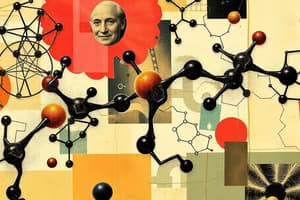Podcast
Questions and Answers
What are the components of a pharmacophore feature?
What are the components of a pharmacophore feature?
- Chemical group, 3D orientation, tolerance, weight
- Chemical function, location, charge, weight
- Chemical function, location, orientation, tolerance (correct)
- Chemical group, 3D location, charge, weight
What is the purpose of ligand-based drug design?
What is the purpose of ligand-based drug design?
- To mimic the active groups on the ligand
- To generate new ligands with necessary chemical groups for biological function (correct)
- To identify features of inactive small molecules and active small molecules
- To examine the 3D structure of the biological target
What is the advantage of ligand-based drug design over receptor-based drug design?
What is the advantage of ligand-based drug design over receptor-based drug design?
- Doesn't require knowledge of the biological target structure (correct)
- Enables identification of necessary chemical groups for biological function
- Facilitates mapping of active molecule on pharmacophore
- Allows direct examination of the 3D structure of the biological target
What is the main focus of receptor-based drug design?
What is the main focus of receptor-based drug design?
What technique joins together to form VIRTUAL SCREENING protocols?
What technique joins together to form VIRTUAL SCREENING protocols?
Flashcards are hidden until you start studying
Study Notes
Pharmacophore Feature Components
- A pharmacophore feature consists of several key components, including hydrogen bond acceptors, hydrogen bond donors, hydrophobic regions, and aromatic rings.
Ligand-Based Drug Design
- The primary purpose of ligand-based drug design is to identify a pharmacophore model that describes the essential features of a ligand that binds to a target protein.
- This approach is advantageous because it does not require prior knowledge of the target protein's three-dimensional structure.
Comparison of Ligand-Based and Receptor-Based Drug Design
- Ligand-based drug design has an advantage over receptor-based drug design because it can be applied even when the 3D structure of the target protein is unknown.
Receptor-Based Drug Design
- The main focus of receptor-based drug design is to design a ligand that is complementary to the binding site of the target protein.
Virtual Screening
- Virtual screening protocols combine multiple techniques, including pharmacophore filtering, shape similarity, and molecular docking, to identify potential drug candidates.
Studying That Suits You
Use AI to generate personalized quizzes and flashcards to suit your learning preferences.




